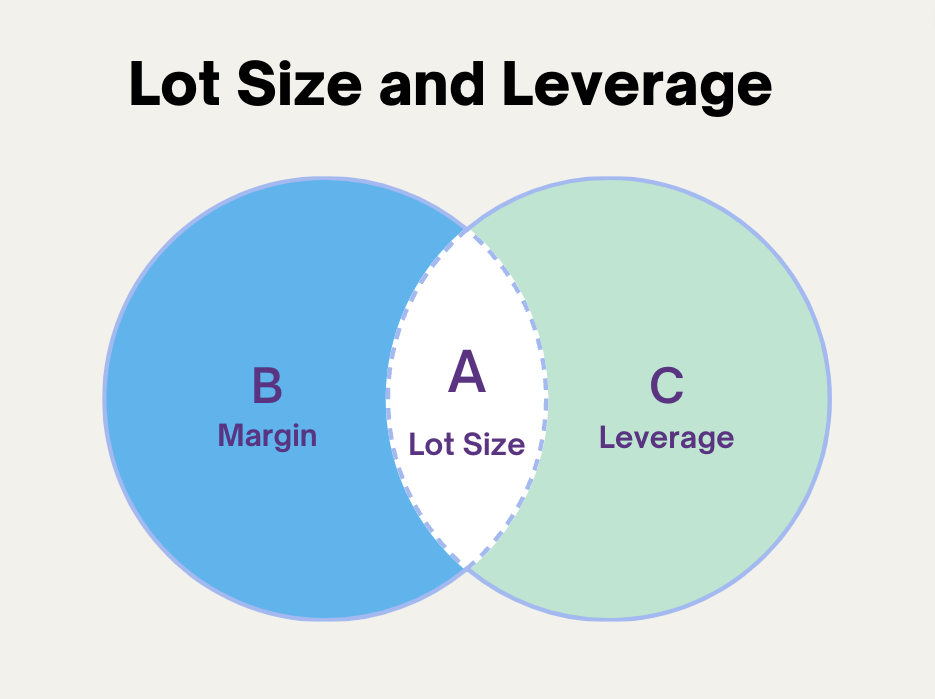When trading forex with leverage it is important to understand the difference between lot size and leverage to be able to choose the correct position size.
In Forex, lot size refers to the position size while leverage acts as a multiplier that can increase the lot size.
Professional traders have mastered the selection process of position size vs the multiplier which gives them an edge when trading the Forex market.
In this article, we will take a closer look at the differences, how to choose lot size and multiplier, some examples, and some best practices.
Key takeaways
- Lot size in Forex refers to the volume of currency units in a trade, while leverage acts as a multiplier of your deposited trading capital, allowing you to control larger positions with less capital.
- They are two distinct concepts that play different roles in determining the size of a trading position and the level of risk involved.
- Choosing ratio and lot size requires careful consideration of risk tolerance, understanding of the underlying market, trading strategy, stop-loss level, and margin requirement.
Table of content
- Lot size vs leverage in forex
- What is lot size in forex?
- Does leverage increase lot size and pip value?
- How to choose lot size and leverage
- Things to consider
- Examples of different trades
- Best practices for position size and leverage
- FAQ
- Final words
- Also read these articles
Lot size vs leverage in Forex explained

The difference between forex lot size and leverage is that lot size is a standardized quantity of currency units in a single trade and leverage is a multiplier of your margin requirement.
Position size and multiplier are two distinct concepts in forex trading that play different roles when it comes to determining the size of the position.
In essence, with a multiplier you can trade larger position sizes in forex with less capital since the leverage multiplies your own money allowing you to open bigger positions.
The lposition has a direct impact on the trade size whereas a micro lot is worth less than a standard lot.
A multiplier on the other hand directly impacts your trading capital and increases the deposited amount depending on how much credit you choose.
With an increased margin, you can afford to trade a larger position size in forex.
What is a lot size in forex?
The lot size refers to the volume of any single trade in Forex where brokers offer different lot size options.
The different positions in Forex are:
- Standard lot: 100,000 units of the base currency
- Mini lot: 10,000 units of the base currency
- Micro lot 1,000 units of the base currency
- Nano lot 100 units of the base currency
A standard lot size of $100,000 in the EUR/USD forex pair means that the pip value is $10.
A mini lot size of $10,000 has a pip value of $1.
A micro lot size of $1000 has a pop value of $0,10.
A nano lot size of $100 has a pip value of $0,01.
Does leverage increase lot size and pip value?
Yes, it does increase position size because you can control more money and therefore trade with a larger position.
Let’s say that you have $5000 in your account and you choose a ratio of 1:100 then you will have $500,000, or 5 lots.
At a position of 5, the pip value is $50.
If you trade forex without margin, $5000 is only 5 micro lots where the pip value is worth $0,50.
Now, let’s assume you have $1000 in your account and you use a 1:10 ratio, then you reach the mini position at $10,000.
A ratio of 1:10 is a good leverage for a $1000 account size.
With a mini lot, each pip is worth $1.
Now should you use 1:150 leverage with your $1000 you would have $150,000 which is 1,5 lots.
This is how debt increases the lot size depending on what margin you choose for a small account.
How to choose them both
When professional traders choose position size and multiplier, these are the factors they consider first:
- Risk tolerance: Before choosing position size and credit you always want to assess your risk tolerance. How much money are you willing to lose on each trade and how much does that translate into pip value? Can you trade a standard position or is it better to trade a mini position based on your risk assessment?
- Underlying market: What market are you currently trading? Are there any news reports coming out soon that could throw off the market for you? Is the forex pair you are trading volatile and less liquid or is it moving slower with higher liquidity?
- Trading strategy: What high leverage trading plan are you going to use? Are you a break-out trader or are you waiting to catch mean reversion trades? Depending on what setup you are trading, you can afford to choose a higher or lower lot size with leverage in Forex.
- Stop loss level: If your stop loss distance is very far away you might need to choose a smaller position to reduce your risk and this can be done by lowering the leverage. If your stop loss level is very tight, choose a higher ratio to take advantage of this skewed opportunity. Our stop loss calculator will help you calculate the perfect distance to your stop loss if you are not sure how to do it on your own.
- Margin requirements: How much money are you going to deposit in your account? This matters because overlevering your account with a small amount of money can be very risky. For example, a good leverage for a $200 account size is rarely more than 250 since the risk will be too much to handle.
All these factors come into play when choosing the perfect position size and multiplier for your trade.
Professional traders study their market, setup, and account size before choosing a position and choosing leverage for Forex.
Things to consider before selecting your ratios
The most important things to consider when choosing which lot size to trade with and how much leverage to add are:
- Total loss
- Maximum profit
- Margin call and liquidation risks
In regards to loss, when trading Forex you need to understand how leverage affects losses before jumping into the markets with your own money.
When trading with high ratios you can lose more money than you have invested unless the broker you trade with has negative balance protection.
A higher ratio increases the risk for loss and adding too much buying power to your Forex trade could end badly.
Related: Forex risk management calculator
Now, on the other hand, profits are increased when trading with leverage and this is one of the biggest benefits of trading the Forex markets.
Many traders have grown a small account size into hundreds of thousands of dollars with skill and practice.
The major risk factors to your account as you choose position size and credit are the margin call risk and liquidation risk.
A margin call is a warning signal from your broker that you receive when your margin requirement has fallen below the minimum level.
If you don’t do anything when receiving the margin call and the market keeps going against you, your account might reach the point of liquidation.
Examples of trades with different levels
Let’s look at some examples of trades in the Forex market with different position sizes and multiplier ratios. For these examples, we’ll assume that you are trading with a balance of $10,000.
Example 1: Low ratios and standard lot size
- Leverage: 1:10
- Lot Size: 1 Standard Lot = 100,000 units
In this example, the trader is using low ratios and a standard position to execute a trade on the EUR/USD currency pair at an exchange rate of 1.2000.
Trade: Buy 1 standard position in EUR/USD at 1.2000
- Trade size: 100,000 EUR
- Margin required (1%): 100,000 EUR * 1.2000 / 10 = $12,000 (using 1% of the trade size as margin)
- Pip value: $10 (approximate, assuming USD as the account currency)
- Risk per pip: $10 (with a stop-loss of 100 pips, the potential loss is $10 * 100 = $1,000)
Example 2: Moderate multiplier and mini postion size
- Leverage: 1:50
- Lot size: 1 Mini lot = 10,000 units
Trade: Sell 1 mini lot in USD/JPY at 110.50
- Trade size: 10,000 USD
- Margin required (2%): 10,000 USD / 50 = $200 (using 2% of the trade size as margin)
- Pip value: $1 (approximate, assuming USD as the account currency)
- Risk per pip: $1 (with a stop-loss of 50 pips, the potential loss is $1 * 50 = $50)
Example 3: High margin and micro position size
- Leverage: 1:200
- Lot size: 1 Micro lot = 1,000 units
Trade: Buy 1 Micro lot in GBP/CHF at 1.3000
- Trade size: 1,000 GBP
- Margin required (0.5%): 1,000 GBP / 200 = $5 (using 0.5% of the trade size as margin)
- Pip value: $0.10 (approximate, assuming USD as the account currency and GBP/USD exchange rate at 1.3000)
- Risk per pip: $0.10 (with a stop-loss of 30 pips, the potential loss is $0.10 * 30 = $3)
You can use these examples as a stepping stone when choosing a multiplier and position for your trades.
The thing that has been exempted from this calculation is the margin trading fee that is added when using more buying power.
Some best practices for beginners
Before you add leverage to increase your lot size there are some best practices to be aware of.
Most professional forex traders abide by these rules without thinking of it since they have been doing it for such as long time.
Therefore it’s worth learning them as a beginner.
- Start with a demo account
- Gradually increase the margin
- Avoid over-leveraging
- Adjust position based on daily volatility
- Diversify your trades
- Keep a trading journal
By following these rules you will make fewer mistakes and could lose less.
My personal favorite as a professional trader is to start with a Forex demo account to feel how the market is behaving and how much strategies work.
However, it’s worth mentioning that Forex trading comes with inherent risks and when a high leverage ratio is added the risks are multiplied.
FAQ
Yes, it linearly increases position size. For example, if you choose a 1:10 multiplier, your position size is increased 10 times.
Multiplier and position size is not the same thing. However, you can reach a 0.01 lot size by using margin when trading Forex.
No, it is not the same as position size. The main difference is that position size is the quantity of units for a Forex trade and credit is the multiplier of your trading capital.
Conclusion
Understanding the concept of lot size and leverage is essential for any Forex trader who is trying to succeed with a smaller account.
Position size represents the quantity of units while credit is the multiplier of your account capital.
Some of the best practices to follow before choosing position size are risk management techniques, assessing the market volatility, choosing a trading strategy, and calculating your multiplier.
By starting with a demo account in Forex, you can practice all these things without running the risk of losing your own money, which is highly recommended by professional traders.
Finding the right balance between lot size and leverage is what is going to set you apart from the rest when trading the Forex markets. As an example, If you’re trading with a $1000 account, selecting the best lot size for $1000 is key to optimizing your strategy.

